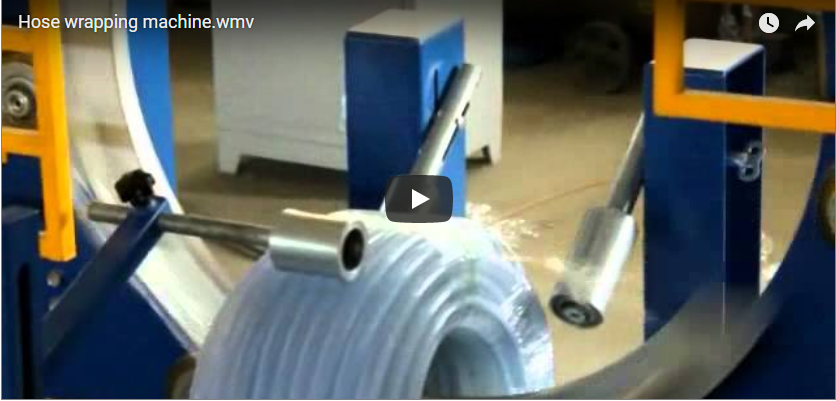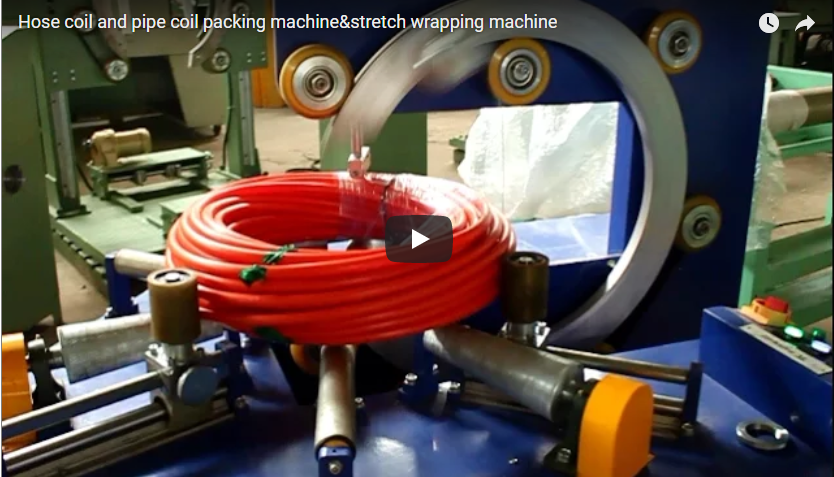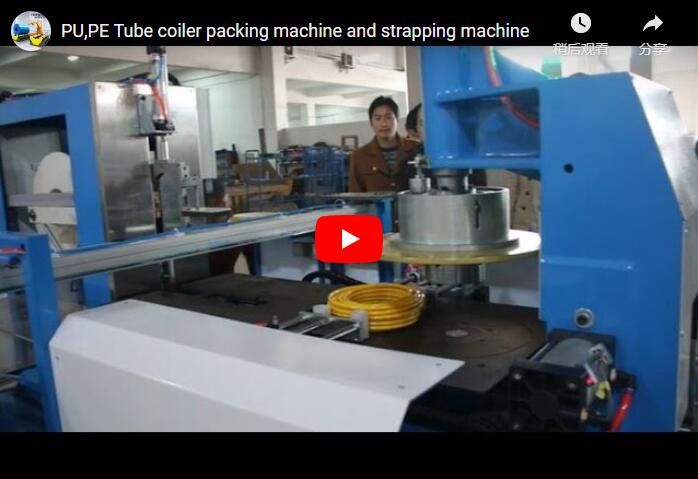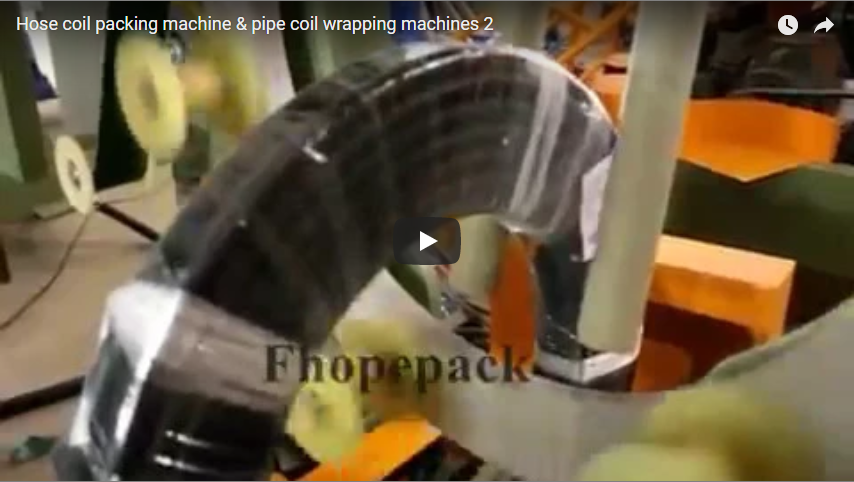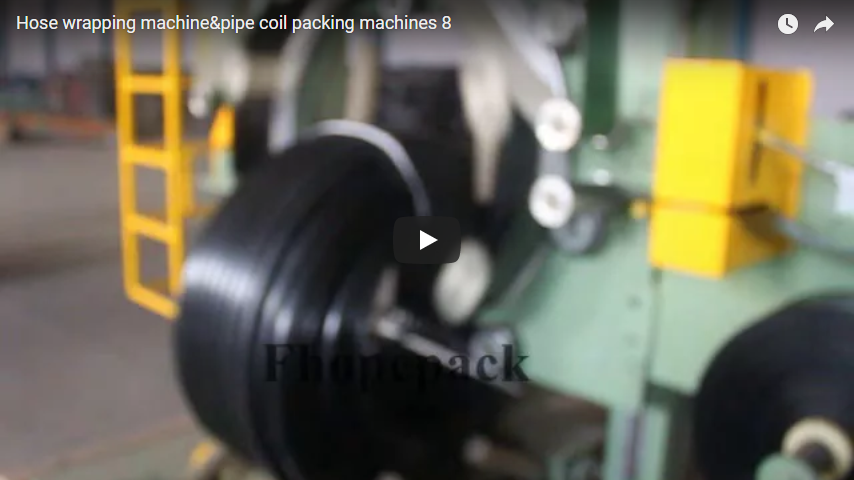Enhancing Efficiency: A Technical Guide to Rubber Hose Coil Wrapping Machines
Rubber hoses, essential components in various industries, can be challenging to handle, store, and transport due to their length and flexibility. Improperly managed hoses are prone to damage, tangling, and contamination. A specialised solution, the Rubber Hose Coil Wrapping Machine, addresses these challenges by efficiently packaging hose coils using stretch wrap film. This guide provides a technical overview of these machines, their operation, key specifications, and applications, aligning with an instructional focus.
1. Understanding the Machine's Function and Operation
A Rubber Hose Coil Wrapping Machine automates or semi-automates the process of securing coiled hoses with stretch film. Its primary function is to provide a protective, stable, and unitized package suitable for storage and shipment.
Typical Operational Sequence (Semi-Automatic):
- Loading: The operator manually places the pre-coiled rubber hose onto the machine's wrapping platform or through the wrapping ring.
- Film Attachment: The stretch film end is manually attached to the hose coil.
- Wrapping Cycle Initiation: The operator starts the wrapping cycle via a control panel or foot switch.
- Rotation and Wrapping: The machine's wrapping ring (or rotating arm, depending on design) revolves around or through the hose coil, dispensing the stretch film under controlled tension. The coil may also rotate on a turntable or rollers to ensure even coverage.
- Film Cutting and Securing: Upon cycle completion, the film is typically cut automatically (or manually on simpler models), and the trailing end adheres to the package.
- Unloading: The securely wrapped hose coil is removed from the machine.
2. Key Components and Features
Understanding the core components helps appreciate the machine's capabilities:
- Wrapping Ring/Arm: Houses the film roll carriage and revolves around the product. Its diameter dictates the maximum coil size.
- Film Carriage: Holds the roll of stretch film. Advanced carriages feature pre-stretch capabilities (stretching the film before application), maximizing film yield and improving load containment.
- Tension Control System: Crucial for ensuring the wrap is tight enough to secure the coil without damaging the hose material. This can be mechanical, electronic, or electromagnetic.
- Rotating Platform/Rollers: Supports and potentially rotates the hose coil during wrapping, ensuring consistent film application across all surfaces.
- Control System (PLC): Manages the wrapping cycle parameters, including rotation speed, number of wraps, film tension, and overlap. Allows for program storage for different coil sizes.
- Automatic Film Cut and Clamp Unit: Improves efficiency and safety by automating the start and end of the wrapping cycle.
- Safety Features: Includes emergency stop buttons, safety guarding, and sensors to protect operators.

3. Technical Specifications Overview
Specifications define a machine's capacity and suitability for specific tasks. Note: Parameters can vary significantly based on model, manufacturer, and customization. The following represents a typical range for a semi-automatic machine:
- Machine Type: Semi-Automatic / Automatic
- Operation Mode: Electric-controlled via PLC
- Coil Handling Capacity:
- Outer Diameter (OD): e.g., 500mm - 1200mm
- Inner Diameter (ID): e.g., 300mm - 800mm
- Coil Width/Height: e.g., 100mm - 400mm
- Coil Weight: e.g., Up to 100kg (varies greatly)
- Wrapping Material: LLDPE Stretch Film
- Film Width: e.g., 100mm - 500mm (Commonly 250mm for ring wrappers)
- Film Roll OD: e.g., Up to 250mm
- Film Core ID: Typically 76mm
- Performance:
- Ring Speed: e.g., 50-100 RPM (Adjustable)
- Wrapping Speed: e.g., 20-40 coils per hour (dependent on coil size and wraps)
- Film Tension: Adjustable (Mechanical or Electronic)
- Film Overlap: Adjustable (e.g., 10%-90%)
- Power Requirements: Typically 380V, 50Hz, 3-Phase (or customized)
- Construction: Often Powder-coated or Stainless Steel frame
- Certification: CE Marking (or relevant regional standards)
4. Industry Applications and Benefits
Rubber hose coil wrapping machines offer significant advantages across various sectors:
- Industrial Supply & Distribution: Streamlines packaging for diverse hose types (hydraulic, pneumatic, water). Ensures coils are protected from dust, moisture, and abrasion during warehousing and transit, maintaining product integrity. Reduces manual wrapping effort and improves packaging consistency.
- Agriculture: Protects irrigation, suction, and discharge hoses during transport to farms and storage in potentially harsh environments. Prevents unwinding and tangling, simplifying handling for farmers and extending hose lifespan through reduced exposure damage.
- Construction: Facilitates better on-site management of large-diameter hoses used for water transfer, concrete placement, or material suction. Wrapped coils are easier to move, store tidily, and are less susceptible to damage from site debris or equipment, enhancing operational efficiency and safety.
- Automotive & Manufacturing: Used for packaging hoses incorporated into vehicle systems or manufacturing processes. Consistent, secure wrapping ensures hoses arrive at assembly lines or end-users in optimal condition, free from contaminants or kinks.
Learn more about Hose Packaging Machines
5. Key Benefits Summarized
- Product Protection: Shields hoses from environmental factors (dust, moisture, UV light) and physical damage (scratches, abrasions).
- Improved Handling & Storage: Creates stable, unitized coils that are easier to handle, stack, and store, optimizing warehouse space.
- Enhanced Efficiency: Automates a labor-intensive task, increasing throughput and reducing packaging costs compared to manual wrapping.
- Professional Presentation: Provides a neat, consistent packaging appearance suitable for retail or B2B distribution.
- Reduced Material Waste: Stretch film provides secure containment with less material compared to other methods like boxing or strapping alone, especially with pre-stretch systems.
6. Selection Considerations
Choosing the right machine involves evaluating:
- Hose Coil Dimensions & Weight: Ensure the machine's capacity matches the range of products to be wrapped.
- Required Throughput: Determine the number of coils needing wrapping per hour/shift to select an appropriate speed and automation level (semi-auto vs. fully automatic).
- Operating Environment: Consider space constraints, power availability, and potential environmental factors (dust, temperature).
- Budget: Balance initial investment against long-term savings in labor, material, and product damage reduction.
- Integration Needs: Assess if the machine needs to integrate with existing production or conveying lines.

7. Maintenance and Best Practices
To ensure longevity and optimal performance:
- Regular Cleaning: Keep the machine free from dust and film residue.
- Lubrication: Follow manufacturer guidelines for lubricating moving parts like bearings and chains.
- Inspect Film Carriage: Regularly check rollers and tensioning components for wear.
- Check Safety Features: Periodically test emergency stops and safety guards.
- Use Quality Film: Employ stretch film appropriate for the machine and application for best results.
By understanding the technical aspects and operational benefits, businesses can effectively leverage rubber hose coil wrapping machines to enhance their packaging processes, protect valuable products, and improve overall operational efficiency.

